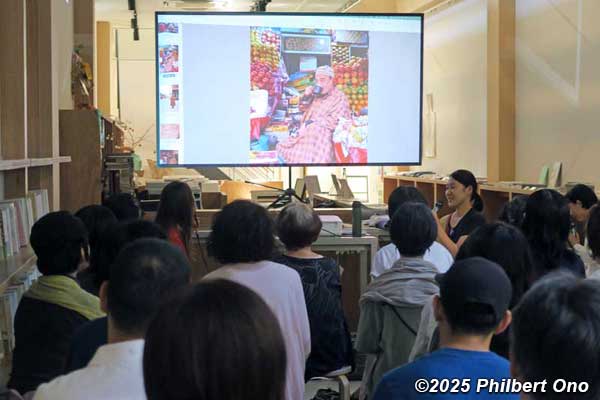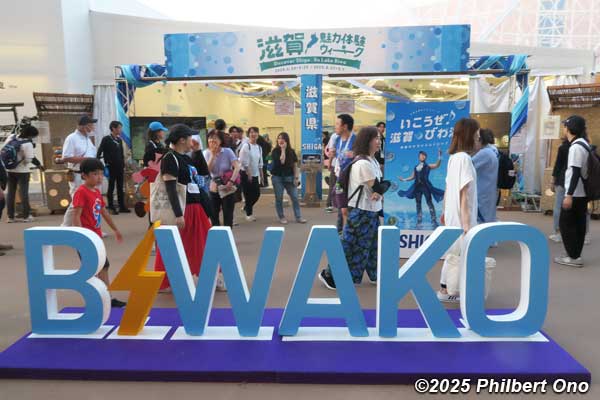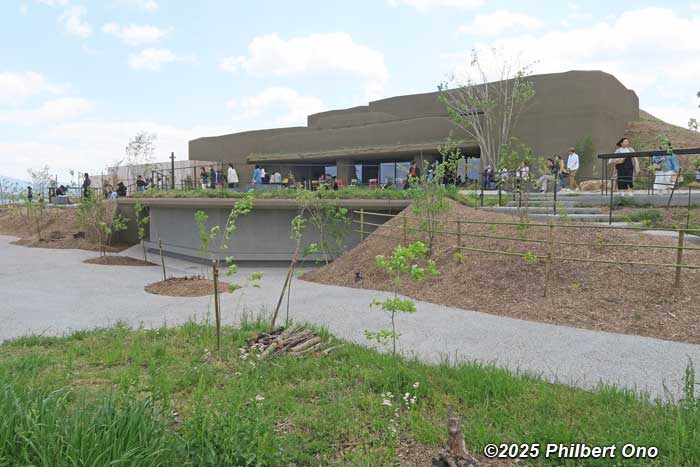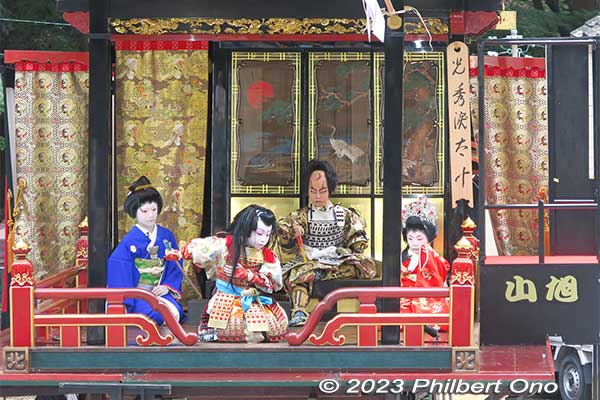
Updated Sept. 8, 2023
Ibuki soba buckwheat noodles (伊吹そば) is a local specialty unique to Maibara, Shiga Prefecture, Japan. It has been cultivated for about 900 years near the western slope of Mt. Ibuki, Shiga’s highest mountain on the border with Gifu Prefecture.
In Japanese, you may hear the word zairai (在来) or zairaishu (在来種) which means “native,” as in “Zairaishu Ibuki soba” or “Ibuki zairai soba.” It refers to soba buckwheat native to Ibuki.
Contents
- Uniqueness of Ibuki soba
- Soba as health food
- Ibuki soba restaurants
- Ibuki soba history
- Ibuki side trips
Compared to other buckwheat in Japan (especially Nagano Prefecture, famous for soba), Ibuki soba buckwheat has three unique qualities:
- The buckwheat’s hull has a distinct aroma.
- The dehulled buckwheat grain is smaller (4.5mm diameter or less) than other buckwheat. Therefore, when it’s ground into buckwheat flour, the flour contains more of the grain’s hull than the grain itself. Since the hull is pleasantly aromatic, the flour and noodles have a stronger aroma.
- The flour and noodles have a light green color due to the grain’s dehulled color.
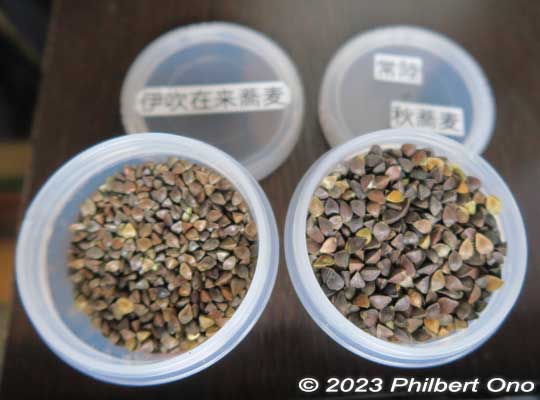
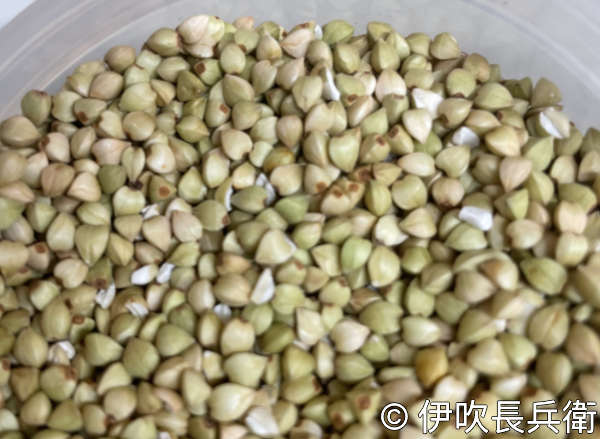
Ibuki soba seeds are planted in mid-August. By mid-September, soba flowers bloom in white. It’s a pretty sight with Mt. Ibuki in the background (top photo). Weeds are removed regularly. In late October when the white flowers wilt and the soba grains under the wilted flowers become black, the crop is harvested with a combine harvest machine driven by the farmer.
The harvested soba grains are then dried and packed in bags. As long as more than 70 percent of the grains are 4.5 mm or smaller in diameter, the bag of soba grain can be labeled Ibuki Zairai Soba.
Since Ibuki soba grains are smaller, the volume of harvests is smaller than the harvests of common buckwheat developed to have a larger grain through selective breeding (改良種). Ibuki soba therefore cannot be produced in large quantities like other buckwheat. The emphasis is therefore on quality rather than quantity.
Ibuki soba: health food
Ibuki soba is also a health food containing essential amino acids, antioxidants, plant protein, fiber, important minerals like manganese, vitamins like thiamin, and less calories (low fat) to boot. It benefits your blood sugar and heart, reduces inflammation, and works against cancer. It’s also gluten-free and unrelated to wheat despite the name “buckwheat.”
Buckwheat is actually a flowering plant and does not belong to the grass family like wheat. So it’s great for vegetarians who need protein and people with gluten intolerance or celiac disease.
However, note that typical soba noodles contain a substantial portion of wheat flour. If you’re gluten intolerant, you need to check or ask if it contains any wheat flour (komugi-ko 小麦粉). Packaged soba noodles will list the ingredients on the packaging.
The good news is that Ibuki soba noodles are made of 100 percent Ibuki soba buckwheat (and natural spring water containing minerals) with no wheat flour, salt, etc., added. This is a major selling point. With such purity, Ibuki soba maximizes its health benefits.
This soba purity also explains the higher prices of Ibuki soba compared to common soba noodles. Typical soba noodles served in restaurants and packaged soba noodles sold in supermarkets are cheap (few hundred yen) because they usually contain wheat flour. Not so with Ibuki soba. You get what you pay for, and the higher price (at least ¥1000/serving) is worth it.
Of course, if you are allergic to soba buckwheat, sadly this blog post is not for you.
Ibuki soba restaurants in Maibara and Hikone
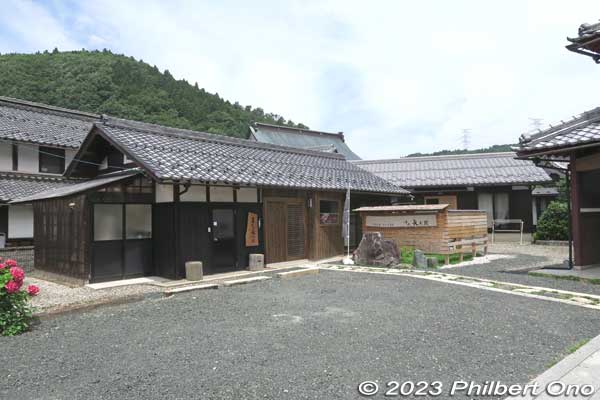
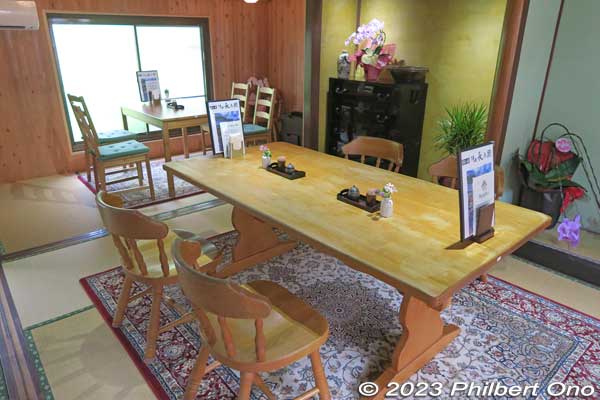
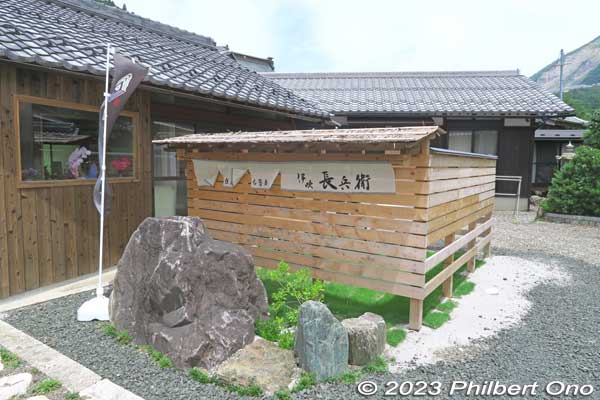
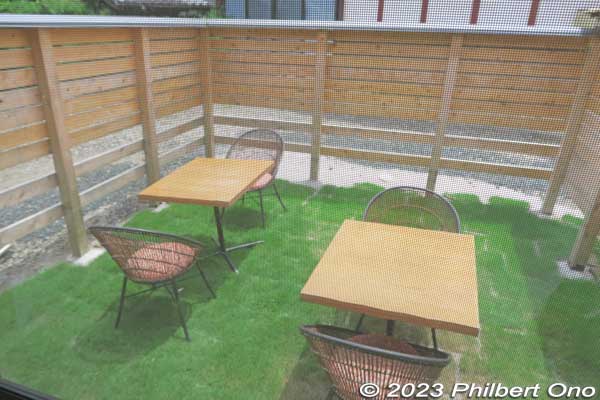
Ibuki soba is served only by a few restaurants in Shiga. Fortunately, in recent years, more Ibuki soba restaurants have sprouted in the Ibuki area in Maibara and Hikone in Shiga Prefecture. They are listed below (and in Japanese here: https://ibuki-soba.jp/shops/).
In Ibuki, a few of the Ibuki soba restaurants are in remote, rural neighborhoods with narrow roads. You would need a compact car (and a good navigation system or Google Maps) to find them. If you’re driving a larger car, find an Ibuki soba restaurant like Soba-no-Sato Ibuki along a larger road.
Ibuki Chobe’e (伊吹長兵衛) soba restaurant
In July 2023, we tried the newest Ibuki soba restaurant named Ibuki Chobe’e (伊吹長兵衛) along a very narrow road in a quiet, rural neighborhood near Anegawa River on the western foot of Mt. Ibuki. (Location on the Google Map below.)
Opened in 2023, Ibuki Chobe’e occupies what used to be an old, Japanese-style house. It has been nicely renovated into a small soba restaurant, complete with an outdoor terrace/patio.
There are tables for two (next to a window), four, and six people. The friendly restaurant owner is from Ibuki, born into a farming family as the oldest son. He and his wife greeted us warmly and kindly explained about Ibuki soba and their menu. The name “Ibuki Chobe’e” (or Chobei) was the owner family’s business name for generations, until it fell into disuse. It was finally resurrected with the opening of their soba restaurant.
Their Ibuki soba is grown in Ibuki without any chemical fertilizers nor pesticides. They also use their own stone mortar to grind the buckwheat grain into flour. They use only Mt. Ibuki’s natural spring water and pure Ibuki buckwheat flour to make the soba noodle dough. No salt, wheat flour, nor preservatives are added, making it 100 percent Ibuki soba and gluten-free.
Ibuki soba menu
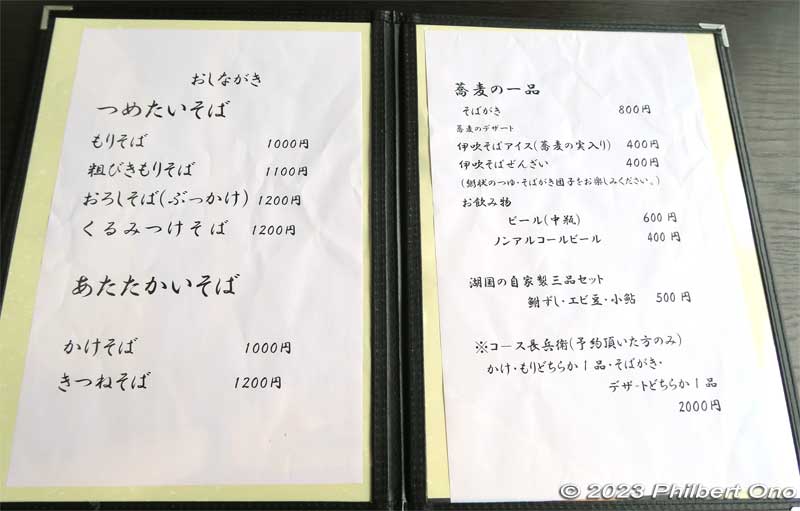
Basically, there are hot and cold soba noodles. Hot noodles are served in a bowl of hot broth and topped with green onions or fried tofu. Kake-soba (¥1000) is the basic bowl of soba noodles in a hot broth. Kitsune-soba (¥1200) is a bowl of hot soba noodles topped with fried tofu.
In summer, cold soba noodles is popular. They come on a platter (photo below) and you dip the noodles in the dipping sauce which has a delicious walnut flavor (the restaurant’s specialty). Grated daikon radish is also a popular garnish for soba noodles. Ibuki is also ideal for growing daikon.
Chobe’e uses all-natural ingredients even in their soba dipping sauce and broth. Their highly selective, natural ingredients include shoyu soy sauce made in Shiga, mirin made in Hekinan, Aichi Prefecture, molasses made in Gifu Prefecture, konbu kelp from Hokkaido, shiitake mushrooms from Oita Prefecture, and katsuobushi bonito flakes from Kagoshima Prefecture.
Side dishes include small lake fish and funazushi fermented fish, and drinks include beer and non-alcoholic beer. The restaurant even has soba ice cream (¥400) for dessert. Didn’t try it, so I can’t describe the taste, but I’m told that it’s like regular ice cream mixed with Ibuki soba flour. Unique flavor.
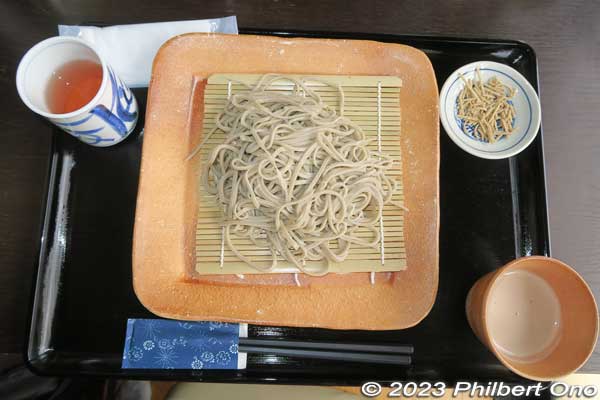
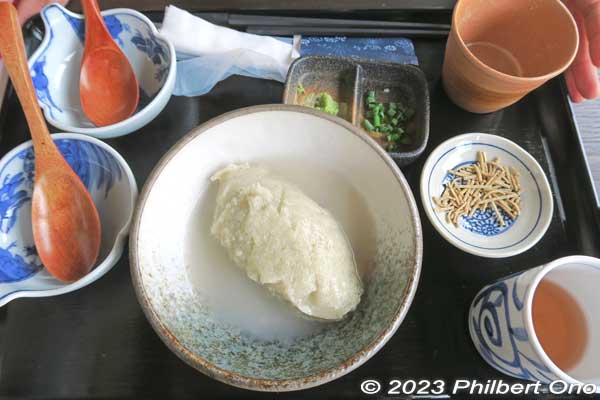
Chobe’e advises that Ibuki soba noodles can get soggy very quickly, so we need to start eating it quickly after it’s cooked. The flavor changes by the second or minute. Smell the noodles, then start eating. Taste how the flavor changes as the minutes pass.
Regarding the wasabi and small green onions, instead of dumping them into the broth, put a little of each onto the noodles directly before you eat the noodles each time. This brings out the soba flavor more. (Oops, I didn’t know this and just put it all in the broth.)
When using the dipping sauce, dip only the lower half of the noodles held in your chopsticks instead of all the noodles. You can then still taste the real flavor of the soba without being overwhelmed by the flavorful dipping sauce. Never thought of that.
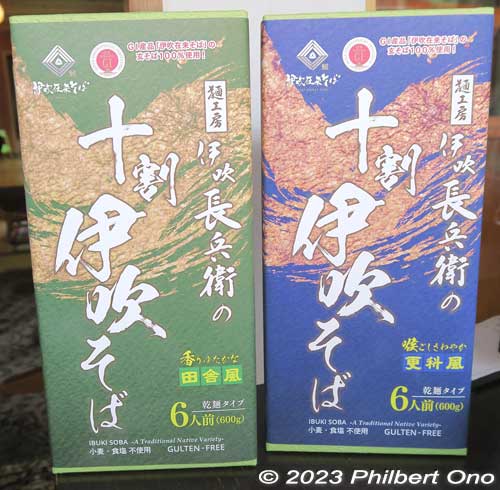
Supermarkets in Shiga might also sell other brands of Ibuki soba.
Ibuki soba restaurants in Maibara and Hikone are listed below with locations on the Google Map. They are members of the Ibuki Zairai Soba no Kai (伊吹在来そばの会) Ibuki soba restaurant association promoting Ibuki soba as a brand. They don’t have any official info in English. Lunch time is usually 11:00 am to 2 pm or 3 pm.
Ibuki Chobe’e (reviewed above) is open only for lunch on Fridays at 11:00 a.m.–2:00 p.m. and on Saturdays and Sundays at 11:00 a.m.–3:00 p.m. Reservations required, call 090-9617-0528 in Japanese. Parking available. Map | https://www.ibukizairaisoba.com/
Kyujiro 久次郎 – Inside a renovated farmhouse further upstream along Ane River. Distinctive red roof. https://www.ibukifarm.com/index.html
Soba-no-Sato Ibuki 蕎麦の里 伊吹 – Highly visible restaurant on the main road with a large “Soba” (そば) sign. Pretty large restaurant. Open every day for lunch, closed on Thu.
Magokokoro 売店喫茶 麻心 – Gift shop, cafe, and soba restaurant in Kozuhara Koryu Center (甲津原交流センター) up north toward Oku-Ibuki. Open for lunch on weekends and national holidays only. http://www.zb.ztv.ne.jp/magokorokyo/sub2.htm
Tsurukian 献上伊吹そば つる亀庵 – Conveniently located near Hikone Castle’s moat. Their Ibuki soba was supposedly offered by the Hikone daimyo to the Tokugawa shoguns. Also serves yaki-saba mackerel sushi and tempura. Open every day for lunch and dinner except Wednesdays. https://ichien.jp/tsurukian/
Dodomomo そば処 百百百百 – Near Ohmi Railways Toriimoto Station in Hikone. Open Thu. to Mon. for lunch only. https://dodomomo044.jimdofree.com/
Map below shows the locations of all these Ibuki soba restaurants.
Ibuki soba history
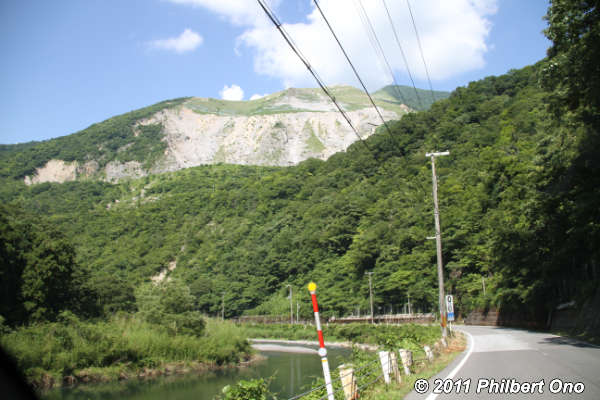
Ibuki soba production dates back to the 12th to 13th centuries when Taihei-Gokokuji Temple (太平護国寺) was active on a terraced plateau (elevation 450 m) on the western slope of Mt. Ibuki. The temple was in the now-defunct village of Taiheiji (太平寺村). Many ascetic priests trained at the temple on sacred Mt. Ibuki and they started growing buckwheat as a precious food source since growing rice on the mountainside limestone did not work.
By the Edo Period (17th to late 19th c.), Ibuki soba became famous nationwide and was mentioned in historical documents. Morikawa Kyoriku (森川 許六 1656–1715), an apprentice of haiku poet Matsuo Basho, mentioned Ibuki soba in his Honcho Monzen (本朝文選) book of haiku poems in 1706.
Famous herbalist Ono Ranzan (小野蘭山 1729–1810) highly praised Ibuki soba in his most important literary work, Honzō Kōmoku Keimō (本草綱目啓蒙, “Dictated Compendium of Materia Medica”).
In 1734, the Zeze samurai clan in lakeside Otsu noted that the white soba flowers halfway up Mt. Ibuki could be seen from Lake Biwa.
Ibuki soba’s unique and raw “wilderness” flavor was so highly favored that the Hikone-based Ii Clan presented Ibuki soba as a gift to Tokugawa shoguns.
Taihei-Gokokuji Temple eventually declined and disbanded after the Edo Period, but farmers in Taiheiji continued to cultivate Ibuki soba as a local delicacy. During the Meiji Period (late 19th century), the village had 298 Ibuki buckwheat fields. In 1889, Taiheiji Village merged with neighboring Ueno Village.
In 1964, due to limestone mining (for cement) on Mt. Ibuki right above Taiheiji, all 14 families moved out of Taiheji to nearby Suijo. Quite a few families then retired from growing Ibuki soba. However, a few farming families continued to grow Ibuki soba in the Toge area (峠地区) near Taiheiji.
Today, the old Taiheiji Village site is off-limits to the public and only has a zigzag road used by the limestone mining company to access the mine on the mountain. The limestone mining has since left a large, white, eyesore scar on Ibuki’s mountainside.
In 1995, the Shiga Prefectural Government and local farmers along the upper reaches of Anegawa River started to resurrect Ibuki soba in their area. The seeds were first purchased from farmers in the Toge area and cultivated to grow more soba seeds.
They have since gradually expanded their Ibuki buckwheat fields along the Anegawa River valley and even on the flatter alluvial fan with good sloping drainage near the river valley entrance. Anegawa River is one of the major rivers flowing into Lake Biwa. The water comes from the Ibuki Mountains which extend to neighboring Gifu and Fukui Prefectures.
Buckwheat can easily crossbreed through honeybees and other insects. To prevent this and preserve the native strain of Ibuki soba, the buckwheat crops are cultivated in the mountainous valley of the upper reaches of Anegawa River near Mt. Ibuki where it is too cold for honeybees, etc.
With cool northwesterly winds in winter, southwesterly winds in summer, and a large temperature difference between night and day, the Mt. Ibuki area is ideal for growing soba.
In 2016, Ibuki farmers formed a farmers’ association named “Breath Farm Ibuki” (ブレスファーム伊吹) to better coordinate their cultivation and improve product quality (rice and soba). As of 2018, there were 31 farmers growing Ibuki soba.
In 2019, Ibuki soba became Shiga’s second agricultural product (Omi-gyu beef was the first) to be certified as “Japan Geographical Indication” to ensure that any product named Ibuki soba (or Ibuki zairai soba 伊吹在来そば) is grown in the Ibuki area and meets high product standards.
Side attractions in the Ibuki area
After a soba lunch in Ibuki, there are a number of nearby sights you can enjoy especially if you have a car.
Anegawa Dam (姉川ダム)
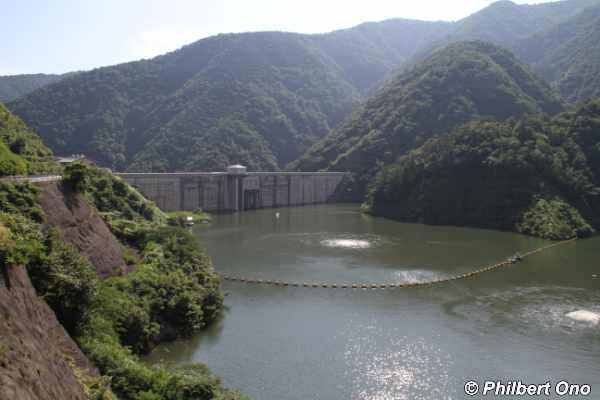

From any soba restaurant in Ibuki, you can drive along Anegawa River further upstream into the mountains. It’s pretty scenic with mountains all around. In spring, you might see cherry blossoms along the river.
Deeper into the mountains, you’ll see Anegawa Dam. There are lookout points, a small park, and a dam operation office (管理事務所) with a visitors’ room for the public. No rental boats though. Map: https://goo.gl/maps/5igCrY82KNAzeTcA9
Ibuki-no-Sato Roadside Station (道の駅 伊吹の里)
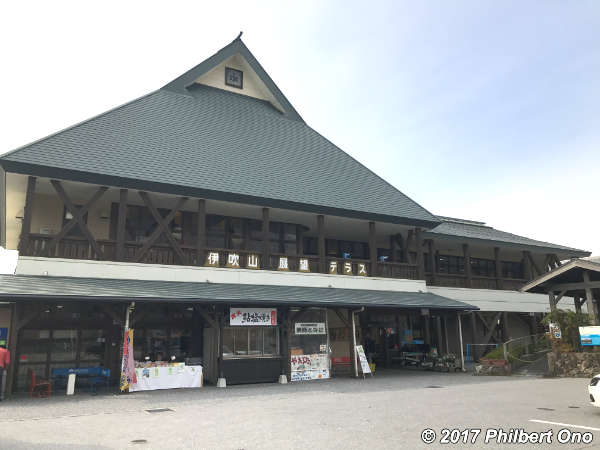

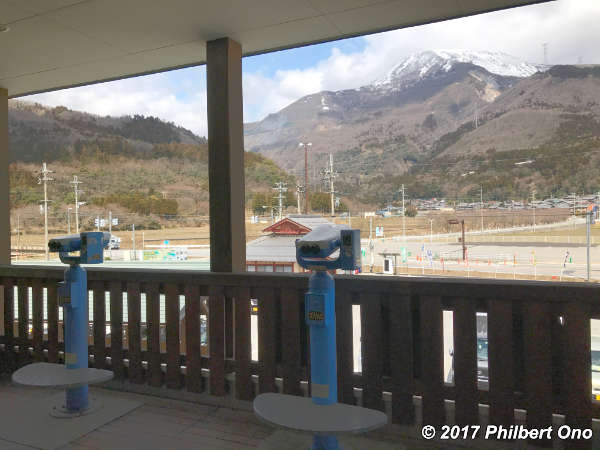
On the way home, a worthwhile stop is Ibuki-no-Sato Roadside Station which opened in 2005. Roadside stations are for tourists and residents traveling by car to rest, shop, and eat.
Ibuki-no-Sato has a farmer’s market, bakery, handicraft shop, restaurant, and ice cream shop (Milk Farm Ibuki). The main draw is local produce including Ibuki daikon radish and other healthy fruits and vegetables sold at lower prices than at the supermarket. Bento box lunches, bottled and canned drinks, and local confections are also sold.
The second floor has a restaurant with a great view of Mt. Ibuki. If you already had soba for lunch, grab a cup of coffee and enjoy the view. I always like to shop at roadside stations. Open 9:15 am to 5 pm. During Jan. to March, closed on Thursdays. Map: https://goo.gl/maps/eaRTAcgk7VtSFLV4A
Mishima Pond (三島池)
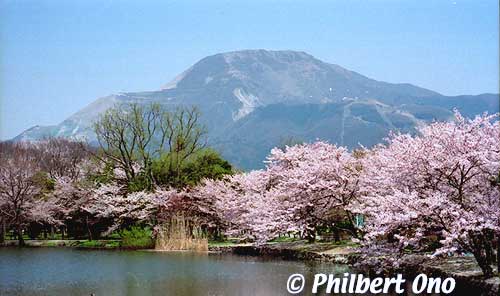
Small, picturesque pond with Mt. Ibuki in the background. Very scenic with cherry blossoms in April or snow on Mt. Ibuki in winter. Well-known locally for migratory birds (especially ducks). Parking available. More photos here. | Google Map
Kamo-Ike-so (鴨池荘)
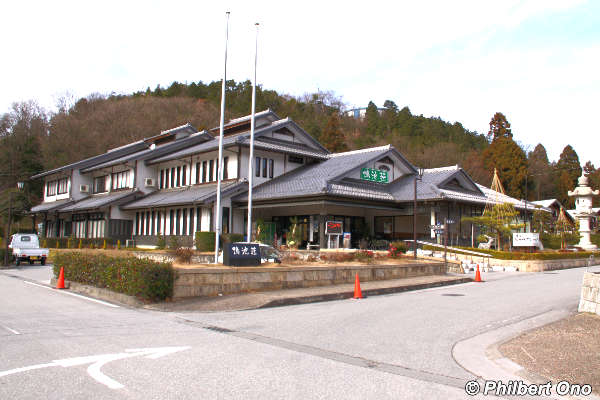
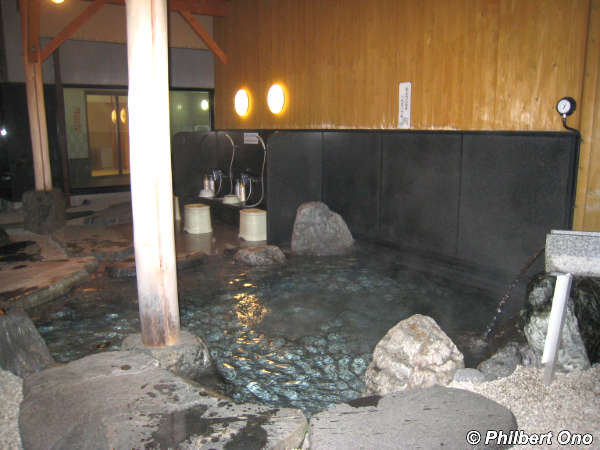
Kamo-Ike-so is a low-cost lodging, restaurant, and bathing facility open to the public. Free parking. It’s within Green Park Santo, an outdoor recreational area with camping/glamping grounds, cottages, exhibition hall, and tennis courts. Adjacent to Mishima Pond.
“Kamo-Ike” means duck pond in reference to Mishima Pond. Kamo-Ike-so has budget accommodations (about ¥4000 to ¥5000 per person) with a nice Japanese restaurant (Omi-gyu beef and other dishes).
The public bath named “Bihada-no-Yu” (Spa for beautiful skin 美肌の湯) is like a hot spring with water good for the skin. It includes a sauna and outdoor bath with a view of Mt. Ibuki. The bath is open from the afternoon (1 pm on weekends and 3 pm on weekdays) until 9:30 p.m. Soap, shampoo, and hair conditioner provided. Towels available for rent. Bathing fee is ¥600 (¥700 on weekends) and ¥400 for primary school kids.
You have to enter the bath totally naked, but baths are segregated and not usually crowded. No one cares what you look like. Great place to warm up during the colder months. https://greenpark-santo.com/kamoikesou/ | Google Map
Joy Ibuki (伊吹薬草の里文化センター)
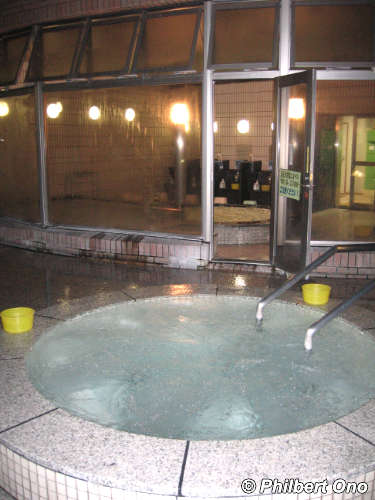
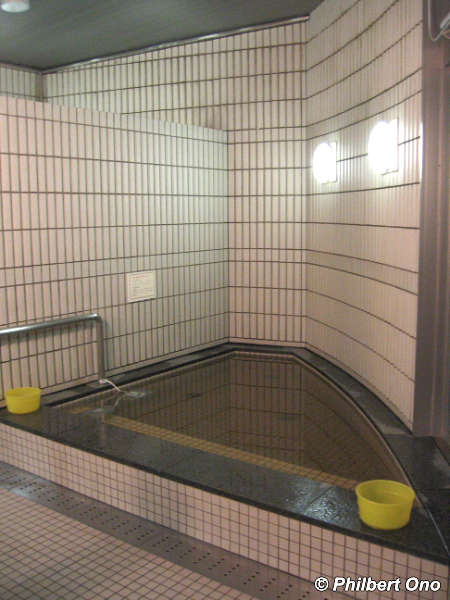

Nicknamed “Joy Ibuki,” the Ibuki Yakuso-no-Sato Culture Center is near Ueno, the entrance to Mt. Ibuki’s hiking trail. It’s a fairly large complex with sports facilities (pool, tennis courts, hockey field, etc.), gym, outdoor stage, concert hall, and the Ibuki Yakuso herb bath (いぶき薬草湯).
Enjoy multiple baths indoors and outdoors including the aromatic herbal bath with seven herbs (like mugwort and peppermint) from Mt. Ibuki. Highly recommended after hiking on Mt. Ibuki or if you just want a unique, hot bath.
The public bath facility is open 12:30 pm to 7:30 pm. Closed on Mondays and Dec. 28 to Jan. 4. Open on Monday if a national holiday and closed on the next day instead. From Nov. to March, open on weekends and national holidays only. https://joyibuki.info/facilities/hot-spa/ | Google Map
Visiting Mt. Ibuki (伊吹山)
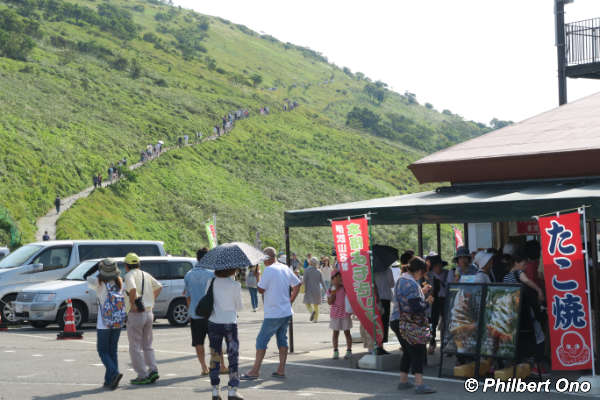
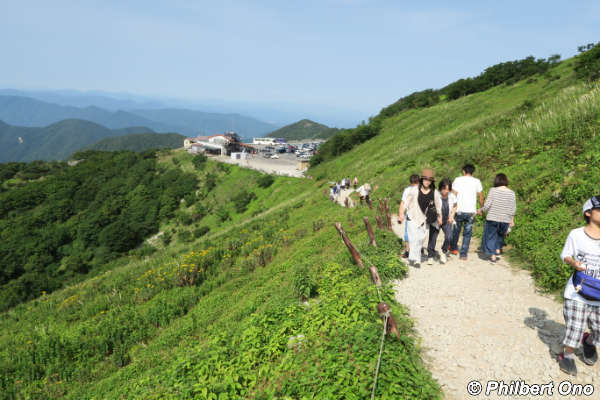
If you have a car, you can easily visit Mt. Ibuki’s summit by driving up the Ibukiyama Driveway toll road from Sekigahara that winds along the mountains to the summit of Mt. Ibuki. The toll road is open from late April to late Nov. Toll is about ¥3,140 per standard vehicle. Closed during winter months due to snow.
If you don’t have a car, there are buses running from JR Maibara Station (East exit, once a day) to Mt. Ibuki summit from mid-April to early Nov. https://maibarand.shiga.jp/ibuki-mt-shuttle-bus/
From JR Sekigahara Station and JR Ogaki Station, Meihankintetsu bus runs a few times every day to Mt. Ibuki summit from late July to late Aug. Roundtrip bus fare is about ¥2100. http://www.mkb.co.jp/pdf/rosen/jikokuhyo/02-30-2-0.pdf
Mt. Ibuki used to have ski lifts and a gondola, but they have been out of service for years. From Ueno, there’s a hiking trail to the summit, but be aware the trail might be closed due to mudslides caused by a typhoon.
Mt. Ibuki is also famous for spring and summer alpine flowers and herbs like mugwort (yomogi). Sold as confections, noodles, and even soft serve ice cream.
Enjoy Ibuki. More photos here.
